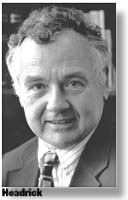| VOLUME 29, NUMBER 25 | THURSDAY, MARCH 26, 1998 |
Computer science meets engineering; CSE department, information/communication technology institute to be established
By SUE WUETCHER
The idea for an initiative-and ultimately an academic unit-bringing together faculty in information and communication technology was featured prominently in Headrick's academic planning document.
"I am convinced UB will be a stronger university by proceeding in this direction," Headrick said, noting that some details of his plan "will probably deserve modification" after review by a wider audience.
According to Headrick's plan, the new CSE department will have a dual affiliation, maintaining ties to both the School of Engineering and Applied Sciences and the new College of Arts and Sciences. The dean of arts and sciences will oversee general education and the undergraduate- and master's-degree programs in computer science, while the dean of the engineering school will be responsible for the undergraduate and master's programs in computer engineering. The doctoral program in CSE will be the joint responsibility of the two deans and the dean of the Graduate School.
The degree programs in electrical engineering will remain in an independent Department of Electrical Engineering residing within the engineering school.
The structure of the new CSE department mimics that of the CSE program at Cor-nell University-which had the fifth-rated CSE program in the latest National Research Council ratings-and is similar to the program at the University of California at Berkeley, which ranked third in the NRC poll, Headrick said.
"It (the structural model) allows for flexibility in faculty orientation, thus allaying concerns of faculty who feel stronger academic connections with one or the other schools and traditions, and see themselves cut off by forcing a choice between them," he said. "In fact, this flexibility could be emphasized by joint appointments, so that engineering members might retain appointments in Electrical Engineering and new faculty might have joint appointments in several other departments in Arts and Sciences and/or Engineering."
This structure "also deals with reality," Headrick observed, since in the field there is no "dichotomous division between engineering (or applied science) on the one hand and basic science on the other. These aspects of the discipline live along a continuum."
In fact, he noted, the CSE department at Cornell describes computer science as an "enabling science"-one in which the science has become so pervasive that it is relevant to every subject studied at the university-and vigorously pursues both its theoretical and applied dimensions.
Headrick said the new department will add 14 faculty members and three staff members during the next five years to handle a projected 50 percent increase in the annual average FTE enrollment of students currently studying computer science and computer engineering. The additional faculty members would be employed to develop a faculty group and expand academic offerings in software systems and software engineering, and supplement current faculty strengths in computer engineering and computer science, he added. These areas of expertise include intelligent systems and multimedia, computational science, computer theory and algorithms, telecommunication and signal processing, very large-scale integrated circuits and computer networks.
The plan for an Institute for Information, Communication and Computation will advance the common interests of the new CSE department, as well as a merger of the School of Information and Library Studies (SILS) and the Department of Communication, which is now in the planning stages, and related programs such as digital arts, geographic information systems and cognitive science, Headrick said.
Membership in the institute, to be known as IICC or I2C2, will be open to all faculty and staff members with teaching, research or service responsibilities in these broad fields, he said.
"One aim of the institute is to foster new ideas coming out of new connections across diverse fields that share interests in I2C2," he said. "In our current environment, we should expect involvement of someone from every school on campus."
The institute will organize seminars and symposia, manage computer-oriented interdisciplinary degree and certificate programs that operate outside of departmental programs, encourage and support interdisciplinary research and initiate grant proposals to support this research, and report to the UB community on future developments and needs in these broad fields. The institute also would serve as a "supportive umbrella structure" for a number of organized research centers devoted to particular subtopics in these fields, Headrick added.
A search will be conducted to identify a director for the institute, someone with academic credentials in computer engineering or computer science, and teaching and research interests that blend into the broader fields of information, communication and computation, he said. The director will report to the provost, who will initially support the institute's budget.
News Services Associate Editor
Provost Thomas E. Headrick will establish a Department of Computer Science and Engineering (CSE) this summer to integrate UB's resources in computer science and computer engineering. At the same time, Headrick will create an Institute for Information, Communication and Computation "dedicated to shaping the future development of these fields at UB and more widely."
At the same time, Headrick will create an Institute for Information, Communication and Computation "dedicated to shaping the future development of these fields at UB and more widely."
Current Issue | Obituary | Comments? | Archives | Search
UB Home | UB News Services | UB Today